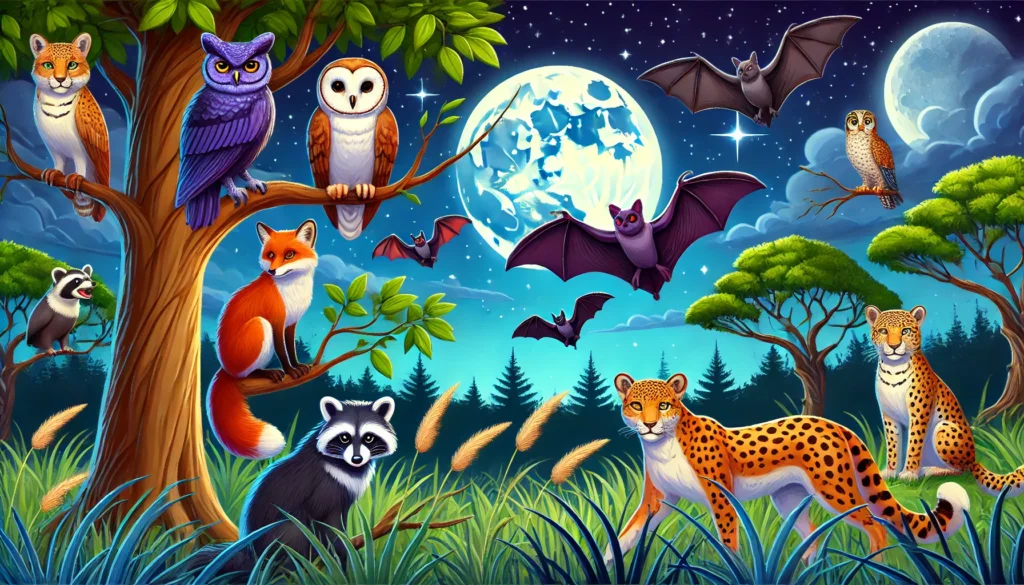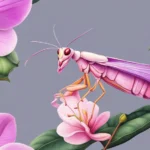Nocturnal animals have evolved remarkable adaptations to thrive in environments where light is scarce. These creatures use specialized senses to navigate, hunt, and communicate in the dark, allowing them to exploit the cover of night for survival. From sharp night vision to highly developed senses of smell and hearing, nocturnal animals exhibit fascinating traits that allow them to flourish while most of the world sleeps. In this article, we explore the top 10 nocturnal animals and the unique adaptations that make them masters of the night.
Owls: Masters of Silent Flight
Owls are perhaps the most iconic nocturnal birds, known for their silent flight and remarkable hunting abilities. What sets them apart is their specialized wing structure, which allows them to glide through the air with minimal noise. This adaptation enables them to sneak up on prey undetected, making them highly effective hunters.
Owls possess large eyes that are forward-facing, giving them excellent depth perception. Their eyes are packed with rod cells, which help them see in extremely low-light conditions. However, their eyes are fixed in their sockets, meaning they cannot move them. Instead, owls can rotate their heads up to 270 degrees to scan their surroundings. Their acute hearing, aided by asymmetrically placed ears, allows them to locate prey hidden under leaves or snow. This combination of exceptional vision, hearing, and silent flight makes owls formidable predators in the night.
Bats: Masters of Echolocation
Bats are another well-known nocturnal species, but they are unique in their use of echolocation to navigate and hunt in the dark. While most mammals rely on their eyes, bats emit high-frequency sound waves that bounce off objects in their environment. By interpreting the returning echoes, bats can create a mental map of their surroundings and detect prey, such as insects.
This ability allows bats to fly in complete darkness without colliding with obstacles or missing their prey. In addition to echolocation, many bat species have excellent low-light vision, and some are even capable of detecting ultraviolet light. Bats play an important role in ecosystems, as they help control insect populations and pollinate plants, making them vital nocturnal pollinators in certain regions.
Foxes: Cunning Night Hunters
Foxes, particularly the red fox, are adept hunters during the night, using their keen senses of hearing and smell to locate prey in the dark. Their highly developed hearing allows them to detect the faintest sounds made by small animals like rodents, even when they are hidden underground. This makes them highly efficient hunters.
Foxes are also equipped with large eyes that enhance their ability to see in low-light conditions. They often hunt by listening carefully for movement, then pouncing with remarkable accuracy. Their sleek, agile bodies enable them to move swiftly and silently through their environment, often under the cover of tall grass or dense foliage. These adaptations help foxes remain elusive predators in the nocturnal world.
Jaguars: Stealthy Stalkers of the Night
Jaguars are powerful nocturnal predators that roam the dense forests and riverbanks of Central and South America. Their impressive night vision and stealthy behavior make them deadly hunters in the dark. Unlike many other big cats, jaguars are strong swimmers and often hunt near water, preying on a variety of animals, including fish, caimans, and capybaras.
Jaguars possess muscular bodies that allow them to take down prey much larger than themselves, including deer and wild boars. Their sharp, retractable claws and powerful jaws enable them to deliver fatal bites with precision. Jaguars have large eyes adapted for low-light environments, allowing them to hunt effectively during the night. Their patterned fur, which provides excellent camouflage in the dappled light of the jungle, further enhances their stealthy approach.
Hedgehogs: Spiny Foragers of the Night
Hedgehogs are small, spiny mammals that are primarily nocturnal, spending their nights foraging for food. Their diet consists mainly of insects, worms, and other small invertebrates. Hedgehogs have a keen sense of smell, which they use to detect prey hidden under leaves or soil.
Hedgehogs are covered in sharp spines that serve as a defense mechanism against predators. When threatened, they roll into a tight ball, using their spines to deter attackers. Although they have poor eyesight, hedgehogs make up for this with their acute sense of smell and hearing, which help them navigate and find food in the dark. Their nocturnal habits help them avoid predators and harsh daytime temperatures, especially in arid environments.
Tarsiers: Tiny Nocturnal Primates with Huge Eyes
Tarsiers are small, nocturnal primates found in Southeast Asia. These fascinating creatures have enormous eyes that are so large relative to their body size that they cannot move them in their sockets. Instead, tarsiers can rotate their heads nearly 180 degrees to scan their surroundings.
Tarsiers are insectivores, and their large eyes help them spot prey in the dim light of the forest. Their hands and feet are specially adapted for clinging to branches, allowing them to leap between trees with agility as they hunt. Tarsiers also have a highly developed sense of hearing, which helps them detect even the slightest movements of insects and other small animals. Their large eyes and acute senses make them well-suited for their nocturnal lifestyle.
Leopards: Silent Stalkers in the Darkness
Leopards are skilled nocturnal hunters that rely on stealth, patience, and power to catch their prey. Found in various habitats across Africa and Asia, these big cats are known for their ability to adapt to different environments, including forests, savannas, and mountains.
Leopards have excellent night vision, which allows them to hunt in near-total darkness. Their sleek, muscular bodies enable them to move silently through their territory, stalking prey with precision. Leopards are solitary animals, and they use the cover of night to ambush prey such as antelope, deer, and smaller mammals. After making a kill, leopards often drag their prey into trees to keep it safe from scavengers. Their ability to hunt at night gives them a distinct advantage over diurnal predators.
Raccoons: Resourceful Nighttime Foragers
Raccoons are nocturnal mammals known for their dexterous front paws and intelligence. Found in North America, raccoons are opportunistic feeders, using their nimble paws to open containers, rummage through garbage, and catch small animals. Their curiosity and problem-solving abilities make them successful foragers in both urban and natural environments.
Raccoons have large eyes that are adapted for low-light conditions, allowing them to navigate and find food during the night. They also have a highly developed sense of touch, with sensitive whiskers and paws that help them explore their surroundings. Raccoons’ nocturnal habits help them avoid predators and take advantage of human-provided food sources in urban areas, making them one of the most adaptable nocturnal animals.
Aardvarks: Nighttime Insectivores with a Keen Sense of Smell
Aardvarks are nocturnal mammals native to Africa, known for their specialized diet of ants and termites. These solitary animals use their strong sense of smell to locate termite mounds and anthills during the night. Once they find a food source, aardvarks use their powerful claws to dig into the mounds and their long, sticky tongues to capture their prey.
Aardvarks have excellent hearing, which helps them detect predators while they forage. Their thick skin protects them from insect bites as they feed. By being active primarily at night, aardvarks avoid the heat of the day and reduce their risk of predation. Their nocturnal lifestyle and unique feeding habits make them one of the most specialized insectivores in the animal kingdom.
Kinkajous: Nocturnal Fruit Lovers
Kinkajous, also known as honey bears, are nocturnal mammals native to Central and South American rainforests. Despite their bear-like name, kinkajous are more closely related to raccoons. They are arboreal animals, spending most of their lives in trees, where they forage for fruit, particularly figs. Kinkajous also have a sweet tooth and are known to raid beehives for honey, earning them their nickname.
Kinkajous have prehensile tails that help them balance and grip branches as they move through the treetops. Their large eyes are adapted for seeing in the dark, and they have an excellent sense of smell and hearing. Kinkajous are highly social animals, often seen grooming and playing with one another during the night. Their nocturnal habits allow them to forage in peace, away from larger diurnal predators.
Conclusion
Nocturnal animals are among the most fascinating creatures in the natural world, each adapted to thrive in darkness through unique behaviors and physical traits. Whether it’s the silent flight of the owl, the echolocation of bats, or the keen senses of the jaguar, these animals have evolved remarkable strategies to survive and succeed in their nighttime environments. Understanding these adaptations not only sheds light on the incredible diversity of life on Earth but also highlights the intricate balance of ecosystems that support nocturnal species.
FAQs
Why are some animals nocturnal?
Many animals are nocturnal to avoid daytime predators, take advantage of cooler temperatures, and exploit food sources that are more available at night.
How do nocturnal animals see in the dark?
Nocturnal animals typically have larger eyes with a higher concentration of rod cells, which are sensitive to low light. This allows them to see in dim conditions where diurnal animals cannot.
What is echolocation, and which animals use it?
Echolocation is the use of sound waves to detect objects in the environment. Bats are the most well-known echolocating animals, using it to navigate and hunt in total darkness.
Do all nocturnal animals have good night vision?
Not all nocturnal animals rely solely on vision. Some, like bats and aardvarks, have developed other senses, such as echolocation or an acute sense of smell, to navigate and find food in the dark.
How do nocturnal animals avoid predators?
Many nocturnal animals rely on camouflage, stealth, and their heightened senses to avoid predators. Some, like hedgehogs, have defensive adaptations such as sharp spines, while others, like foxes, use agility and speed.
Are there any nocturnal animals that are also active during the day?
Some animals, known as crepuscular species, are most active during dawn and dusk but may also be active at night. Examples include certain species of foxes and deer.


